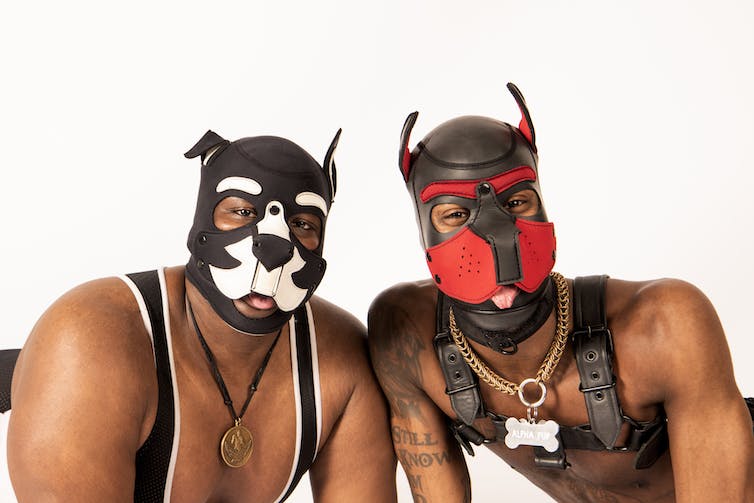In recent years, the world of kink lifestyles and subcultures has gained increasing attention. Kink is a general term that includes various expressions of unconventional or non-traditional sexual desires. This encompasses a wide array of practices, including power dynamics, intense sensations/stimuli, role-playing and more.
One such form of role-play that is often misunderstood is known as pup play. Pups are consenting adults who roleplay by dressing and acting as young canines, or pups.
We are researchers within nutrition and health research with a focus on diverse gender and sexualities. In this project called Puppy Philms, we seek to more deeply understand how meanings ascribed to bodies are socially constructed for gay, bisexual, transgender and queer men within the pup community.
For this project, we used a method called cellphilming. The term cellphilm was coined to describe films made with cell phones. We worked with pups who created cellphilms to learn more about their community, particularly how being a pup might help people navigate body-image concerns.
We recruited 17 self-identifying gay, bisexual, transgender and queer men who are pups across Canada. They attended three workshops and each of them created a cellphilm in which they talked about being a pup and how their body image is shaped in the pup community.
What is pup play?
(Deontè Lee)
Pup play has its roots within kink communities and gay BDSM and leather subculture. Alongside the sexual component, pup play is viewed by many to be a social activity.
Studies have demonstrated many reasons why people might participate in kink and BDSM activities. For example, personal development, self-expression, overcoming anxiety, relaxation, and to be more socially comfortable. Kink play may also improve interpersonal relationships.
The pup community fosters connections and gathers at various pup events. These include pup competitions where a designated “play space” allows them to cuddle each other, wag their tails and bark.
Pups often wear pup gear like collars and pup masks or hoods. Some individuals within pup communities take on the role of pup “handlers,” which means they assume a more dominant role within pup play.
Cellphilming
Cellphilming is an art-based research method and serves as a tool for advocacy that researchers seeking to disrupt traditional roles within research can use. It enables participants to exercise their creativity and take control and ownership of their narratives, facilitating the expression of ideas that can be more challenging to convey through traditional interviews.
Research becomes an artistic and reflective process. The resulting cellphilms are pieces of art that can create a sense of solidarity among communities while changing social values about gender, sexual orientation and bodies.
The Puppy Philms Project
(Deontè Lee)
Our previous work noted that many gay men navigate body-image tensions by identifying within gay subcultures that celebrate bodies that are more diverse than the dominant thin and muscular body standards. We also found that challenging and disrupting dominant ideas about masculinity can be helpful for some men dealing with body-image concerns.
Yet no studies have looked at the relationships between body image and pup communities. With Puppy Philms, we sought to gain a deeper insights into this relationship through cellphilming.
Body image and pup play
Three findings about pup play and body image emerged from our research. First, participants discussed how the pup community can reinforce body standards for men. As one participant said, “the body expectations for pup communities are not really different from the body expectations from the cis gay man culture.”
However, many participants also felt pup communities were spaces where dominant ideas about men’s body standards and masculinity were changed, lessened or lacking altogether. As another participant noted, “body image doesn’t really matter in the pup community, and that’s sort of the point. Just be a puppy.”
(Deontè Lee)
The pup headspace – a state of mindfulness relaxation — has also been associated with therapeutic benefits. Participants reflected on how the process of becoming a pup helped them change their feelings about their bodies and overcome body image concerns.
One participant noted, “…while I’ve got the [pup] mask on and I’m at the events, I don’t tend to think about it. But soon as the mask comes off then I start to think about my body-image issues again.”
Our study sheds light on the positive aspects of the pup community as a social and accepting space, where identifying as a pup represents a sign of resilience and defiance against social norms.
Pow! Comics are a way to improve queer men’s body image
Unleashing queer activism
Participants felt inspired to create their cellphilms and saw them as powerful tools for activism. They aimed to inform the public about pup play and break the stigma surrounding it.
This drive for activism took various forms; some participants submitted their cellphilms to film festivals, and others travelled to the United States and Europe to showcase their cellphilms and share their experiences. In collaboration with the participants, we organized community screening events (one in Montreal and an upcoming one in Toronto), furthering the reach of their narratives.
Participants saw the potential to use their cellphilms for a greater purpose than just this research. As one participant said, “just this possibility of spreading out what we were talking about really stimulates me a lot.”
Artistic activists remind us that “we can ‘queer’ mass culture by making it say things it was never designed to say, and act in ways it was never meant to act.” Perhaps the participants’ cellphilms can help make our culture more open to diverse bodies, genders and sexualities.

